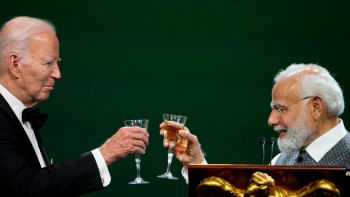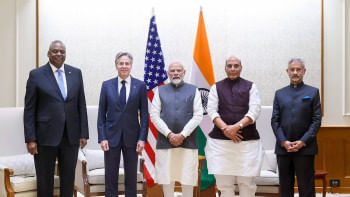How Maoism is still alive in India

India now ranks fourth globally in terms of defence spending. In recent years, the country's military has grown at an incredible pace. About $75 billion was allocated for this sector in the last budget.
Indian policymakers often cite threats from "rivals" China and Pakistan to justify increased defence spending. Even if a few soldiers die on the border, at the hands of the two countries, it becomes a top headline in the Indian media. It attacks the country's self-esteem, and the call for revenge gets louder. Psychologically, India vies for military superiority over China and Pakistan by any means, the result of which is the strengthening of its military.
But, surprisingly, such a mighty military has been fighting India's Maoist guerillas for decades. Amid the current election tension, multiple reports of clashes with Maoists in Jharkhand have come out. What's more important than how many soldiers have been killed by which side is this: how are the late Chinese leader's ideals still alive in India after 48 years? What is the social reason behind this, and will we see a solution soon?
Dateline Keoratala, 1972
One of the fathers of Maoist politics and militancy in India is Charu Mazumdar, and his associates were Kanu Sanyal and Jangal Santhal among others. All met their fate long ago. While in custody, Mazumdar died without getting emergency medicine for his heart disease. At the time, there were allegations of torturing the thin-framed leader as well. All this happened 52 years ago when Congress was in power. But it's clear that even after Mazumdar's body burned to ashes, under police surveillance, in Kolkata's Keoratala crematorium in July 1972, the ideology was not wiped out; rather, it was cultivated elsewhere, beyond Naxalbari.
The organisers of "Naxalbari Peasant Armament"—Mazumdar, Sanyal, and Santhal—considered Mao Zedong to be their guru. A quote from "Chairman Mao" was their favourite: "Politics is war without bloodshed while war is politics with bloodshed." Naturally, the question arises, what is the form of bloody politics of today's Maoists in India? And why has India's government failed to stop them in five decades?
Areas of the Maoists
In the 70s and 80s, after losing its key organisers in West Bengal, Indian Maoist politics gradually spread to Andhra Pradesh. Now, its centre is mainly the Dandakaranya area, situated in the middle of many states. It's also known as the "red corridor" and encompasses areas nestled around Chhattisgarh, Odisha, Andhra, and Maharashtra. Maoism also influences Jharkhand and Bihar. These idealists are found in the relatively forested and tribal-dominated areas of these regions. That is, this group is concentrated in the poor eastern region of India. Economic deprivation is the main reason behind Maoism's grip in these regions.
Researchers have shown that tribals are even poorer than the non-tribal poor population. The way economic liberalisation made major cities glitzy did not translate to tribal communities, who make up around nine percent of the national population.
The government claims that poverty has greatly diminished over the past decade, but in this regard, tribal areas of the eastern region are lagging behind the national average. Perhaps that's why the radical change promised by Maoism is still appealing in these places. Historical caste-based discrimination has also necessitated change at the bottom of society.
Outside Dandakaranya or nearby areas, the two words, "Urban Naxal," are being widely circulated in newspapers aligning with RSS-BJP. The term refers to the urban Maoists, whose area of work is in the arena of art, literature, and culture, who ideologically believe that the current exploitative system in South Asia cannot be changed by the so-called politics of votes. Maybe because of this, when elections come, tension and raids shoot up in Naxal areas. Perhaps this is happening right now: while the national polls, which begin on April 19, pit many parties against each other, the state security forces are scheduled to fight the Maoists.
Battle against 'Urban Naxals'
The three ideological adversaries declared by the current "ruling family" of India are Christians, Muslims, and Communists, all three being minorities.
Religious minorities, primarily Christians and Muslims, have been largely marginalised through various political initiatives. The statehood of Jammu and Kashmir, once a Muslim-majority state, has been revoked in a legislative process. The three Christian-dominated states—Mizoram, Meghalaya, and Nagaland—have only four seats in the Lok Sabha; in the battle for 545 seats, these issues are of little concern. Meanwhile, the political clout of communists who have confidence in the polls survives only in Kerala. They are now fighting for survival in their old strongholds of West Bengal and Tripura, and hence, are not a big threat to the BJP anymore. But the RSS family still sees the "left" as a special adversary. It's very sensitive about the "Maoist attitude," especially regarding education and culture.
Tagging anyone who is anti-establishment as "Urban Naxal" is the trend right now. When filmmaker Vivek Agnihotri made the movie Buddha in a Traffic Jam, targeting urban Maoists, Home Minister Rajnath Singh himself congratulated the creator. Agnihotri later wrote a book Urban Naxals, highlighting the movie's background, while pro-BJP papers raved about the movie and book. Another attempt to culturally belittle the Maoists was the movie Bastar: The Naxal Story, in which there was a feeble attempt to pit Maoism against patriotism. There is no attempt to find the socio-economic reasons as to why people are attracted to the call for "change" in these creative endeavours.
Around the same period, the director of Bastar: The Naxal Story made the movie The Kerala Story, whose interest was "Muslim society." It was also appreciated by the RSS family and was allowed to air on Doordarshan, the state-owned television channel, before the Lok Sabha polls. It's quite clear who the government wants to help.
In reaction to Naxalites, akin to that of Muslims, the BJP and its organisers have always sought to impose their cultural vision on the state apparatus. This sentiment may have coined the official name of the Maoist problem for the security officials in India: "LWE" or "Left Wing Extremism." In a high-level meeting of such officials in Rajpur, Chhattisgarh on January 21, Home Minister Amit Shah announced that the Maoists would be eliminated within three years, from both villages and cities.
What's new from Amit Shah's side is that he has set a timeframe to uproot Maoism. But the question is, is it feasible to implement? Security agencies claim, yes. Compared to the pre-BJP situation from 2005 to 2014, "LWE terrorism" has halved in the decade since 2014. Altogether, only about 45 districts now harbour them.

There are disputes about the security officials' claims, but there is some truth too. Maoists have lost a lot of ground when compared with the situation two years ago. The reason for this "success" is the coordinated efforts of the administration and ruling politics.
Apart from coordinated security raids by various state forces, various economic and cultural projects are being taken up across Dandakaranya. The RSS family has laid great emphasis on building temples there. Through the religious-conversion initiative "Ghar Wapsi (Returning Home)," the tribals who are being drawn to the campaign are also being used to gather information about the Maoists. Besides, there are financial incentives for those who surrender.
The main implementing authority of Ghar Wapsi is Vishva Hindu Parishad, and the main areas the campaign is targeting are Telangana, Andhra, and Jharkhand. With the many supporters of this initiative, semi-military forces of various names were once formed, which assisted the state in suppressing the Maoists. It's very much stopping tribals with the help of tribals. "Salwa Judum" was one such force in Chhattisgarh, formed during the Congress regime. After widespread complaints of human rights violations, India's Supreme Court banned the group.
In addition to these initiatives, another major move the administration took, with almost the same objective, was banning activities of the Revolutionary Democratic Front (RDF), a mass organisation of progressive intellectuals, in various places. This coalition-like organisation worked with radical elements in student, labour, and cultural circles in various cities across India. The government had alleged that armed Maoists had ideological links with them. Besides writer and social activist Arundhati Roy, the main intellectuals of the organisation have been arrested or interrogated at various times. Due to this, the spread of "Maoist thought" in urban areas has been greatly hampered.
The RDF says that to suppress the pen-in-hand radicals, they are being tagged with gun-carrying Naxalites. Whether this claim is true or false, Indian society's freedom of speech has suffered greatly in the process of eradicating the RDF. Democracy activists are particularly objecting to the way the Unlawful Activities (Prevention) Act is being used against intellectuals and activists. The government, however, considers Maoist ideology-based armament to be an internal security threat to India. Hence, it seeks to deal with this issue culturally, administratively, politically, and militarily, akin to its actions in Kashmir and Northeast India.
Are Maoists on the verge of extinction?
Although there are various factions and groups of Maoists across India, the main political force of this movement is the Communist Party of India (Maoist). Many of the old leaders—like Kishenji, Ganapathy, and "Kishan Da"—are no longer in the field; some have died while others have retired. The current organisers also stay on the field with a death warrant. The CPI-Maoist leaders usually keep two to three levels of leadership in place to prevent any disasters. However, given the huge amount of power, the government has bestowed on law enforcement agencies, it's difficult for the Maoists of Dandakaranya to hold on to the "free zone" in an organised manner, in the face of ongoing operations. After its apparent success in Kashmir and Northeast India, the country's security administration wants to swiftly control this "problem" in the eastern region. But the problem lies elsewhere.
Wealth inequality is increasing rapidly in South Asia, including India. Meanwhile, corporations under the umbrella of dominant political parties are gaining control of natural resources in marginal and tribal areas. Given the circumstances, will the dissatisfaction and disillusionment plaguing the bottom of society go away? If the conventional politics of voting does not provide a satisfactory solution to these grievances, what is the alternative? Will the protests against unjust social conditions stop if weapons are taken away from the few hundreds or thousands of poor people demanding change somewhere in the villages and cities? Can people keep their heads bowed forever when their stomachs and brains are full of resentment? Will the events that did not occur in West Bengal in 1972 occur in Dandakaranya in 2024?
Altaf Parvez is a researcher of history.
Views expressed in this article are the author's own.
Follow The Daily Star Opinion on Facebook for the latest opinions, commentaries and analyses by experts and professionals. To contribute your article or letter to The Daily Star Opinion, see our guidelines for submission.

 For all latest news, follow The Daily Star's Google News channel.
For all latest news, follow The Daily Star's Google News channel. 










Comments